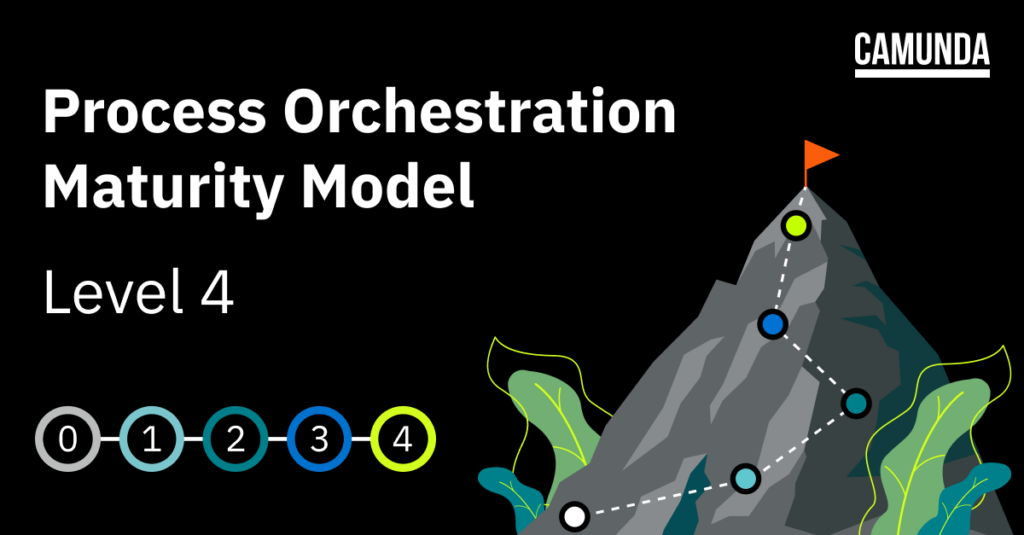Welcome to our fourth and final blog in our series on the Process Orchestration Maturity Model. Be sure to read our first, second, and third blogs in the series before reading this one.
If you’ve gotten this far in our series, congratulations, your company has already started broad IT automation initiatives and is starting to explore broader process orchestration KPIs. That gets you to Level 3. Now what does your organization need to do to achieve Level 4 of the Process Orchestration Maturity Model?
What is the Process Orchestration Maturity Model?
To recap, in this blog series we’ll be discussing how you can advance your process orchestration maturity to overcome business challenges and understand where to focus in the future. As companies begin to look at their automation goals, there are different factors and drivers that help them assess their maturity around process orchestration.
This is the fourth post in the series. You can find the first post here, the second post here, and the third post here.
Reminder of the drivers for Process Orchestration Maturity Model?
Let’s start with a brief refresher on the Process Orchestration Maturity Model drivers so that we can apply them to the discussions later. The drivers are described below:

What is the awareness of process orchestration as a distinct competency in the organization? Why does it matter to the organization?

What goals are the organization trying to achieve through its process orchestration practice?
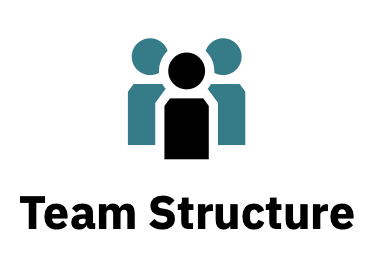
Who defines the standards and policies for how process orchestration should be used? Who is responsible for implementing these changes?

How does the organization define process orchestration success? How capable is the organization of tracking that success?

What technology philosophies, platforms, and solutions power the organization’s process orchestration efforts?
Level 4 is reflected by strategic and scaled adoption within the organization
Another quick refresher on the Process Orchestration Maturity Model levels and we see that Level 4 is achieved when your company is showing strategic and scaled adoption of process orchestration within the organization.

At Level 4, the organization is considered mature as it relates to the maturity model. If you map your current organization’s status against the five maturity drivers, it might look something like this at Level 4:

Your company has a clearly defined strategy around technology, methodology and people to execute process orchestration at scale.

Your organization has a demonstrated track record of delivering strategic value to the organization through process orchestration.

Your IT team has implemented global CoEs that provide enablement, training, internal consulting, and connector development for process orchestration.

Your organization is defining and measuring large-scale process orchestration KPIs.

Your company has built a technology stack that fits their exact needs and has a dedicated process orchestration strategy.
All the work your organization put in in levels 0 through level 3 are now beginning to pay off and you have a clearer view of KPIs and metrics. You have built a solid foundation and now can expand that within the organization at a rapid pace. Your Center of Excellence (CoE) is the place to go for technical expertise for process orchestration.
At Level 4, your technical experts are creating solutions quickly because of the organization’s domain expertise. These experts are able to speed up time-to-automation to solve complex business problems within the organization.
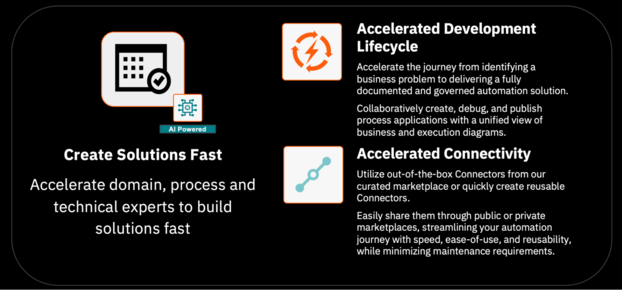
With the skills and expertise gained with previous automated processes and the creation of the CoE, the development lifecycle is accelerated within the organization. This includes everything from identifying the business problem to delivering a fully documented and automated solution.
Developers and business analysts are collaboratively creating, debugging and publishing process applications with a unified view of the business.
The use of Connectors from the the curated Camunda Marketplace and reusable connectors have allowed you to accelerate connectivity between departments and all over the organization. You can share these Connectors (and reusable subprocesses) through public and private marketplaces allowing the streamlining of your automation journey. This accelerated connectivity is accomplished with speed, ease-of-use, and reusability, while minimizing maintenance requirements.
Finally, let’s check in one last time with Camundanzia Insurance and see where they are currently as it relates to the maturity model.
Where is Camundanzia Insurance now?
As of our last article, Camundanzia has not quite reached Level 4 in the Process Orchestration Maturity Model. They have made significant strides in that direction including:
- Implementing and reusing Connectors and subprocesses to create solutions faster while minimizing errors
- Beginning to look at KPIs and SLAs for implemented processes and making improvements based on the insights provided
- Collaborating with business and developers to provide a more holistic approach to process orchestration
They have started down the right path to level 4, but still have some remaining components to explore. For example, Camundanzia is beginning to work with multi-tenancy using separate tenants for different organizations. Multi-tenancy reuses a single Camunda cluster, allowing customers to create and provision tenants for multiple use cases or teams. Creating multiple tenants helps scale automation to more teams and initiatives while minimizing costs and operational overhead.
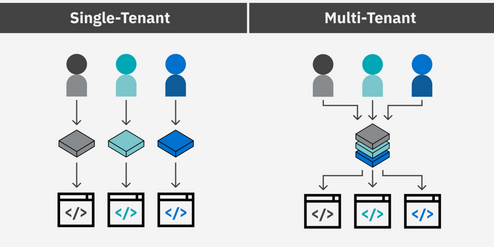
In the case of Camundanzia, they have outlined the following tenancy for their organization:
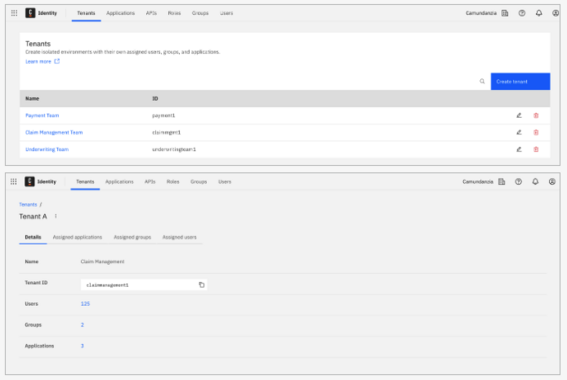
In addition, Camundanzia is investigating using separate clusters within these tenants to streamline deployments.
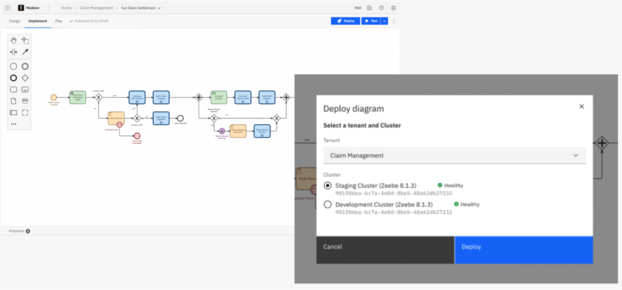
Using tenants also extends to Operate as well allowing you to select the tenant.
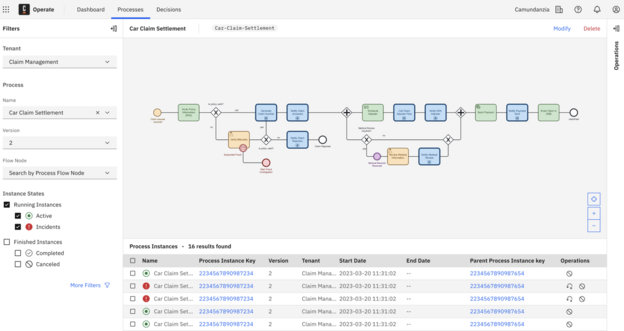
There are additional things that Camundanzia can do to position themselves solidly at Level 4 of the Process Orchestration Maturity Model. For example, Camundanzia can build an internal marketplace of their reusable components to make these more accessible throughout the organization.
Predictive process orchestration can help Camundanzia improve processes and decision targets with Artificial Intelligence (AI). Camundanzia’s data scientists can leverage ML-ready data sets with other data within the organization to review trends and make business decisions.
With Camunda Optimize, Camundanzia can make intelligent process improvements by identifying patterns and bottlenecks in their BPMN models.
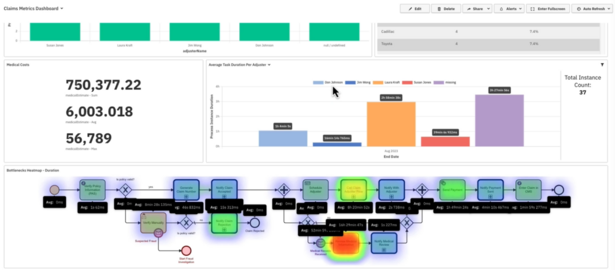

These insights can lead to improving the specific business use cases so that these ML-ready data sets can be customized to provide the right data for future decisions. The review and analysis of the information gathered can also lead to improved business decisions.
With these additions, Camundanzia Insurance can achieve Level 4 of Process Orchestration Maturity, but keep in mind—continuous improvement is required to stay ahead of the game.
Proving the value of process orchestration
Advancing on your path to process orchestration maturity gives you visibility and strategic insight into your processes. This drives stronger alignment between business and IT, which leads to faster automated outcomes while minimizing costs and reduced risk. Process orchestration maturity empowers organizations to achieve a culture of continuous improvement and adaptability toward any changes that arise.
Organizations can drive toward strategic and scaled adoption with advanced maturity. Companies that take the journey to process orchestration maturity get more value from automation and orchestration than their competition. By taking this approach, they are aligning their efforts with specific business outcomes which pushes them toward digital transformation success.
Don’t forget
Thank you for tuning into our Process Orchestration Maturity Model blog series. Don’t forget to continue your education around this subject by checking out this webpage.
You can also review the webinar: Process Orchestration Maturity: A Practical Journey to hear about all levels and examples.
